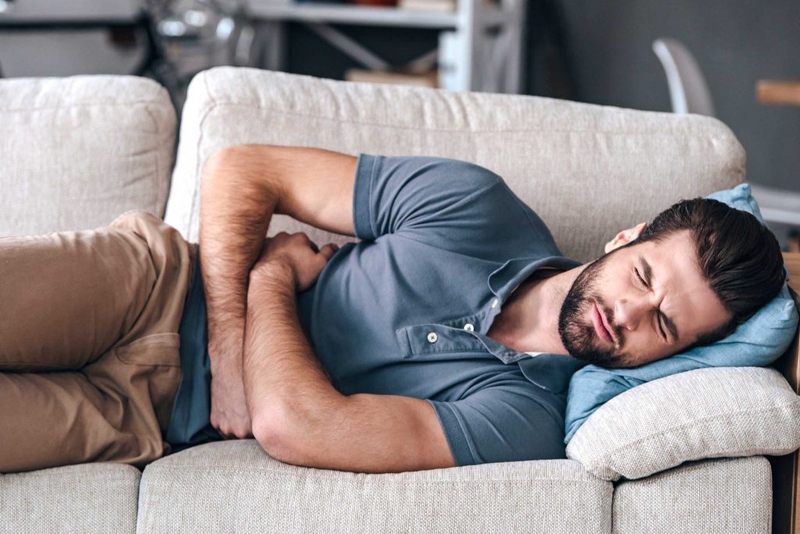It is true that you will have a hard time pinpointing the exact reason of having pain in left side of stomach after eating. It is always tricky to make a correct diagnosis for abdominal pain, as there are several structures and organs in the abdomen. If you experience pain on the left side of your abdomen, it could involve your small intestine, stomach, or colon. Several minor and some potentially dangerous conditions can cause this pain. Learn more about it now!

What Causes Left Side Stomach Pain after Eating?
You Have Peptic Ulcer Disease
Sometimes, painful sores develop in the walls of the stomach usually when the stomach's protective lining is no longer functional. Your stomach keeps producing acid to digest food, but that acid can lead to a condition called peptic ulcer disease (PUD). Some common causes of PUD are bacterial infections, alcohol abuse, and excessive use of NSAIDs.
Treatment:
To treat your pain caused by PUD, it is important to avoid alcohol consumption, smoking, and NSAIDs. You may have to use proton pump inhibitors to prevent acid secretions. Antacids may also help neutralize acid in your stomach, which in turn will help reduce pain.
You Are Lactose Intolerant
Naturally present in cheese, milk, and ice cream, butter, and soy products, lactose is a sugar that your body digest with the help of an enzyme called lactase. You develop lactose intolerance if your body does not produce enough of lactase. If you have lactose intolerance and you still eat food that contains this sugar, you will develop pain in left side of stomach after eating. You may also develop bloating and gas.
Treatment:
You can manage your condition by avoiding soy and dairy products. If you want to use milk products, only opt for the ones with reduced lactose. Be sure to read labels before buying anything from the market. Sometimes, taking lactase substitutes in the form of capsules, tablets, and liquid drops also helps.
You Are Gluten Intolerant
Yet another reason of experiencing abdominal pain is to eat food that contains gluten. Gluten is a protein found in rye, wheat, graham flour, and barley. Your immune system takes gluten as an invader which triggers an immune response. This can cause pain, bloating, and other similar issues.
Treatment:
You need to work with a dietician to learn how to follow a gluten free diet. You need to include more fruits, veggies, potatoes, and corn in your diet to avoid a reaction.
You Have Constipation
A simple reason behind your pain in left side of stomach after eating is constipation. You are constipated if you pass hard, painful stools, or you do not pass stools at least three times a week. You are likely to develop this issue when you do not drink enough water or your fiber intake is on the lower side.
Treatment:
Maintain an active lifestyle. Even a short 15-minute walk a day can work wonders to reduce your symptoms. Increase your intake of water – drink no less than 8 glasses of water every day. Include fresh fruits, veggies, and whole grain in your diet to improve digestion.
You Have Heartburn
You are likely to experience stomach pain after eating if you have heartburn. The condition causes a burning sensation of your abdomen – you may also experience a painful sensation in your chest. Your condition may become worse when you lay down.
Treatment:
Avoid cola drinks, say no to smoking, and include right food in your diet. Take antacids to neutralize the stomach acids. You may also have to take medicines to limit the production of acids in the stomach. Keep your head elevated when sleeping to get some relief.
You Have Irritable Bowel Syndrome
If you experience pain in your stomach after every meal, it could be because you have a condition called irritable bowel syndrome (IBS). You may also experience the alternating diarrhea and constipation. Other symptoms include tiredness after eating, flatulence, bloating, diarrhea, constipation, and mucus in stool.
Treatment:
Avoid overeating, coffee, alcohol and products with milk content. Keep a high-fiber diet. If you need further help, consult your doctor and he may offer you with medications and supplements.
You Have Diverticulas
There are small pockets, called diverticulas, in the lining of the intestine. These punched-out holes can become infected and inflamed. Not getting enough fiber from your diet is one of the reasons why you develop this condition.
Treatment:
Increase your intake of fiber by including fiber-rich food in your diet. You can also take fiber supplements. Sometimes, you need to take antibiotic drugs to treat your pain.
You Have Intestinal Obstruction
In case of any blockage in your digestive system, the food you eat may not get into the intestines. Hernia, adhesion, and tumor are some of the most common causes of this intestinal obstruction.
Treatment:
It is important to talk to your doctor to help identify the underlying cause of obstruction. This will help determine the best treatment option.
You Have Colorectal Cancer
Continuous pain in left side of stomach after eating may be associated with serious issues, such as colorectal cancer. The condition is more common in people over 50 years of age.
Treatment:
Early detection helps treat the cancer; therefore, it is important to seek medical attention when you experience continuous and severe abdominal pain.
When to See a Doctor?
In most cases, your abdominal pain does not require any treatment. You should see your doctor if your pain persists for more than a week and you have other symptoms, such as unexplained weight loss, vaginal bleeding, loss of appetite, long-term diarrhea or bloating, and a burning sensation when you urinate. Seek immediate medical attention if you experience pain after an abdominal injury.
View All Comments /Add Comment